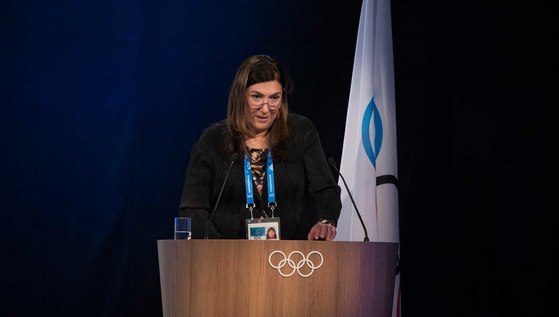|
I am not a masochist, and clearly as a singer in a rock ‘n’ roll band I prefer the roar of the stadium’s affection to the whistles and boos of town-hall politics. But I must say I quite enjoyed the trouble I got into about a year ago when I was the lone man honored as part of Glamour’s Women of the Year awards. My favorite trash-talking tweet came from a woman who said that in my defense, my glasses did make me look like a 75-year-old granny from Miami. Or another who said it was inspiring how I’d overcome “the adversity of being a millionaire white dude.”
I was aware and I was glad that I was being offered up as a firestarter for a debate the magazine rightly wanted to have about the role of men in the fight for gender equality. It seemed obvious to me that the sex who created the problem might have some responsibility for undoing it. Men can’t step back and leave it to women alone to clean up the mess we’ve made and are still making. Misogyny, violence and poverty are problems we can’t solve at half-strength, which is the way we’ve been operating for a few millennia now. I say it seemed obvious to me, but if I’m honest, it didn’t always. I have been home-schooled on this issue in a very powerful way by my wife Ali and our two daughters. The news that I was getting Glamour’s first Man of the Year award amped up a conversation in our house–that Eve and Jordan think is the only conversation–about the fact that, as Jordan reminds me, there is nowhere on earth where women have the same opportunity as men. Nowhere. Which has something to do with the fact that around the world, there are 130 million girls who are not in school. That’s so many girls that, if they made up their own country, it would be bigger in population than Germany or Japan. Denying girls what an education offers–a fair shot, a path out of poverty–means that women can work the land but can’t own it; they can earn the money but can’t bank it. This is why poverty is sexist, as we say, and say loudly, at ONE to anyone listening, especially the world leaders who are supposed to guarantee universal access to education by 2030, the target they set in the Sustainable Development Goals. There isn’t just room for righteous anger at the injustice of all this, there is a need for it and for outrage at the violence–physical, emotional and legal–that perpetuates it. But there is also, in the facts, room for hope. Because the research is clear–it’s plain on the page and has been proved on the ground–that funding girls’ education isn’t charity but investment, and the returns are transformational. Give girls just one additional year of schooling and their wages go up almost 12%. Give them as much schooling as boys get and things really start changing. Closing the gender gap in education could generate $112 billion to $152 billion a year for the economies of developing countries. When you invest in girls and women, they rise and they lift their families, their communities, their economies and countries along with them. They rise–and they lead. That is, unless they continue to be held back and pushed down. Which could be the case. We’ve had a hard lesson over the past year that the march of progress is not inevitable. Sexism is rampant, conscious and unconscious. I’m still working on my own. Hopelessness is running high right now, and cynicism is cresting. But these are things the world can’t afford. There are 130 million girls counting on women and men to get our collective act together, push for better policies and pressure politicians to do more and fund more of what works–things like the Global Partnership for Education, which is due for replenishment early this year. The key lesson in my own home-schooling is something Ali has been saying to me since we were teenagers: don’t look down on me, but don’t look up to me, either. Look across to me. I’m here. It just may be that in these times, the most important thing for men and women to do is to look across to each other–and then start moving, together, in the same direction. Making education a priority is a way of making equality a priority, and even men with limited vision should see that’s the only way forward.
1 Comment
THE INTERNATIONAL OLYMPIC COMMITTEE (IOC) IS FORGING A BOLD NEW PATH IN ADVANCING GENDER EQUALITY IN THE SPORTING ARENA AND BEYOND, AS THE IOC SESSION RECEIVED TODAY AN UPDATE FROM THE GENDER EQUALITY REVIEW PROJECT. FOLLOWING THE IOC EXECUTIVE BOARD APPROVAL OF 25 BOLD AND CHALLENGING RECOMMENDATIONS, THE IOC IS LEADING THE WAY IN RAISING AWARENESS OF THE IMPORTANCE OF GENDER EQUALITY ON AND OFF THE FIELD OF PLAY.
From governance to human resources, to funding, sport and portrayal, the IOC is focusing on achieving tangible results to strengthen gender equality across the entire Olympic Movement through these action-oriented recommendations. The ultimate goal is to assist in removing barriers preventing women and girls from participating in sport at all levels. Chair of the IOC Gender Equality Review Project Marisol Casado said: “While recent years have seen improvements in gender equality in sport, we need more, and we need to do it quickly. These 25 recommendations aim to make substantial change and swiftly. The IOC is in a prime position to lead the way in bringing parity in gender equality, and today’s decision is a giant step forward toward achieving our objective.” There are 25 recommendations: 8 in areas in which the IOC has already made significant progress; 8 of which the IOC will lead with an implementation plan currently under development; and 9 of which are for International Federations (IFs) and National Olympic Committees (NOCs) to lead. The next step is to publish the full report and develop an approach to undertake gender equality assessments within the broader Olympic Movement and beyond. The Gender Equality Working Group was led by Casado, an IOC Member and President of the International Triathlon Union. She was joined by IOC Members, NOCs, and Summer and Winter IF representatives who had been selected for the leadership of gender equality efforts within their own organisations. "THESE 25 RECOMMENDATIONS AIM TO MAKE SUBSTANTIAL CHANGE AND SWIFTLY. THE IOC IS IN A PRIME POSITION TO LEAD THE WAY IN BRINGING PARITY IN GENDER EQUALITY." - Marisol Casado One of the key actions is centered around avoiding portraying gender bias and stereotypes. A pilot programme is already underway at the Olympic Winter Games in PyeongChang, where a set of principles and guidelines for balanced portrayal of both genders has been shared with IOC stakeholders. They have been asked to “road test” these guidelines in their own activities during the Games, and to share feedback and comment on their experiences. Using this stakeholder input, the next step will be to build a robust set of gender portrayal guidelines that can be implemented widely. Closely collaborating with stakeholders in gathering and responding to their valued feedback will lead to a strengthened sense of ownership, and to enhanced implementation of the guidelines throughout the IOC and the wider Olympic Movement. The IOC’s strategic objective around gender equality calls for growing female participation at the Olympic Games to 50 per cent. This significant, yet achievable, increase will build upon recent advances in gender parity at the Olympic Games. For example, in London in 2012, there was a 44 per cent female participation rate. Further expanding female participation, the Olympic Games in Rio de Janeiro in 2016 boasted the highest-ever number of women competitors, with female athletes comprising 45 per cent of total participants. Further demonstrating progress, on the final day of the Games, equal numbers of women’s and men’s events will take place. This groundbreaking achievement represents a major stride forward, as both the 2010 Vancouver and 2014 Sochi Olympic Winter Games did not host any women’s events on their final days of competition. |
Archives
April 2019
Categories
All
|
Proudly powered by Weebly


 RSS Feed
RSS Feed